N-cadherin promotes epithelial-mesenchymal transition and cancer stem cell-like traits via ErbB signaling in prostate cancer cells
- Authors:
- Min Wang
- Dong Ren
- Wei Guo
- Shuai Huang
- Zeyu Wang
- Qiji Li
- Hong Du
- Libing Song
- Xinsheng Peng
-
Affiliations: Department of Orthopaedic Surgery, The First Affiliated Hospital of Sun Yat-sen University, Guangzhou, Guangdong 510080, P.R. China, Department of Pathology, The First People's Hospital of Guangzhou City, Guangzhou, Guangdong 510180, P.R. China, State Key Laboratory of Oncology in Southern China/Department of Experimental Research, Sun Yat-sen University Cancer Center, Guangzhou, Guangdong 510060, P.R. China - Published online on: November 26, 2015 https://doi.org/10.3892/ijo.2015.3270
- Pages: 595-606
This article is mentioned in:
Abstract
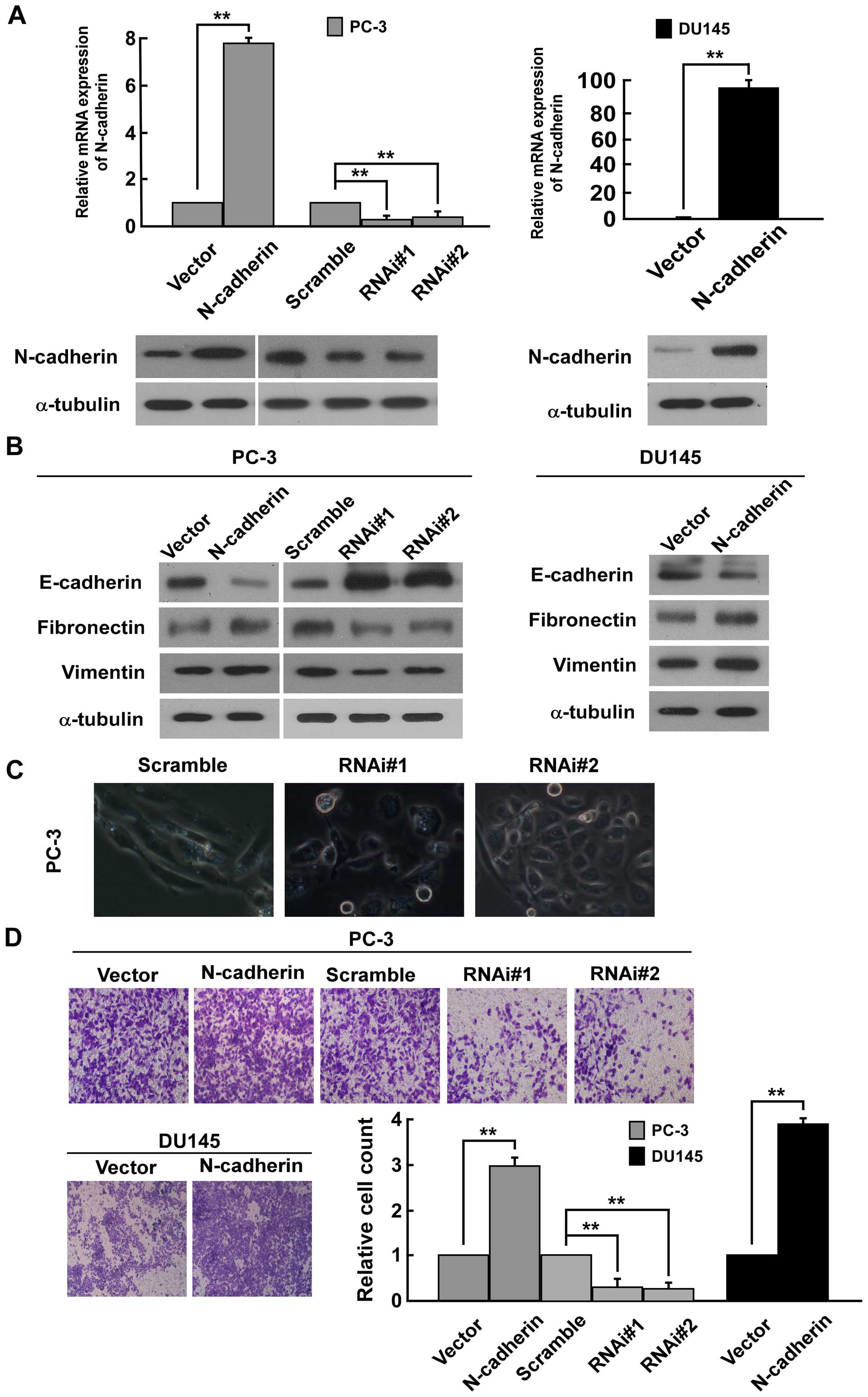 |
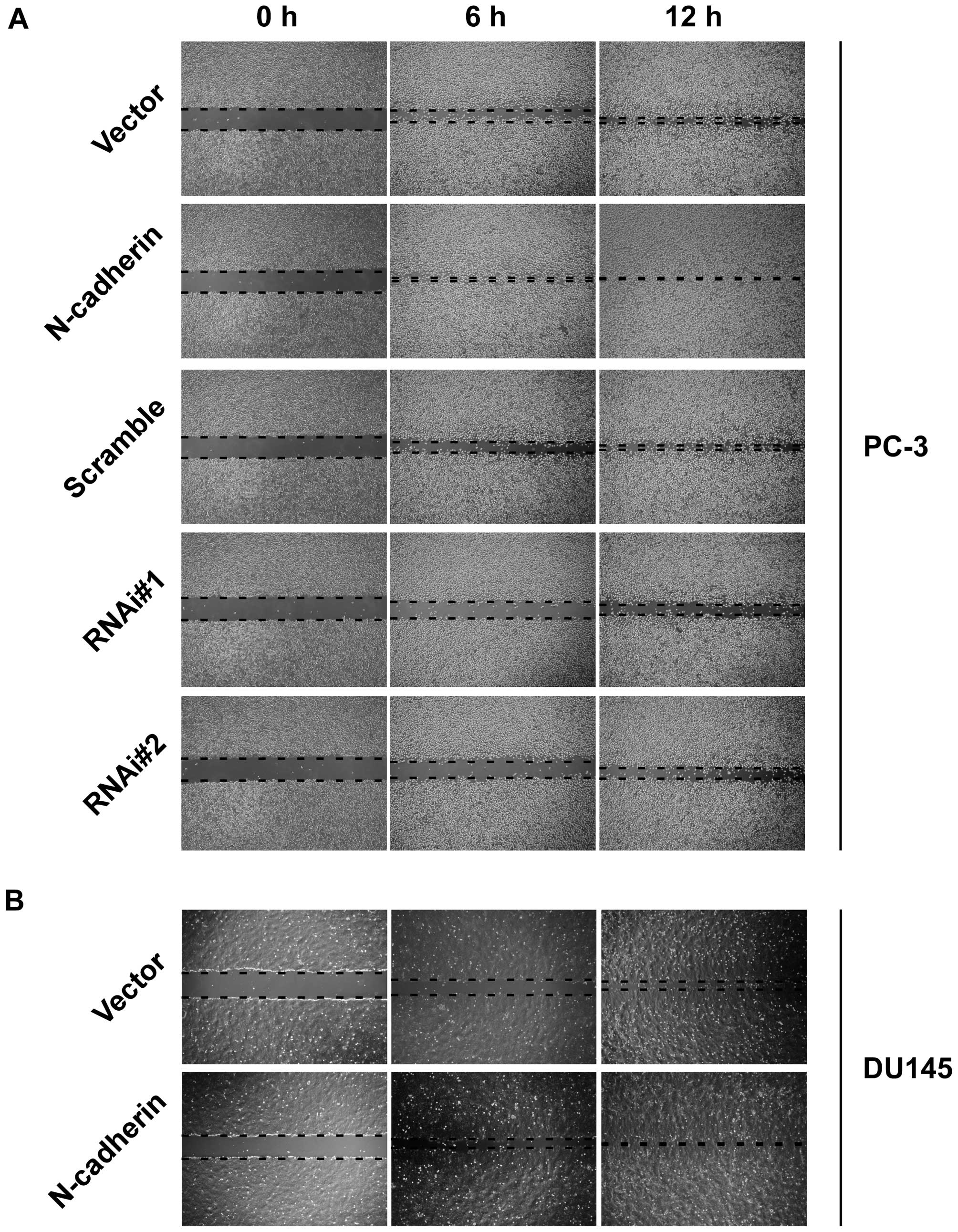 |
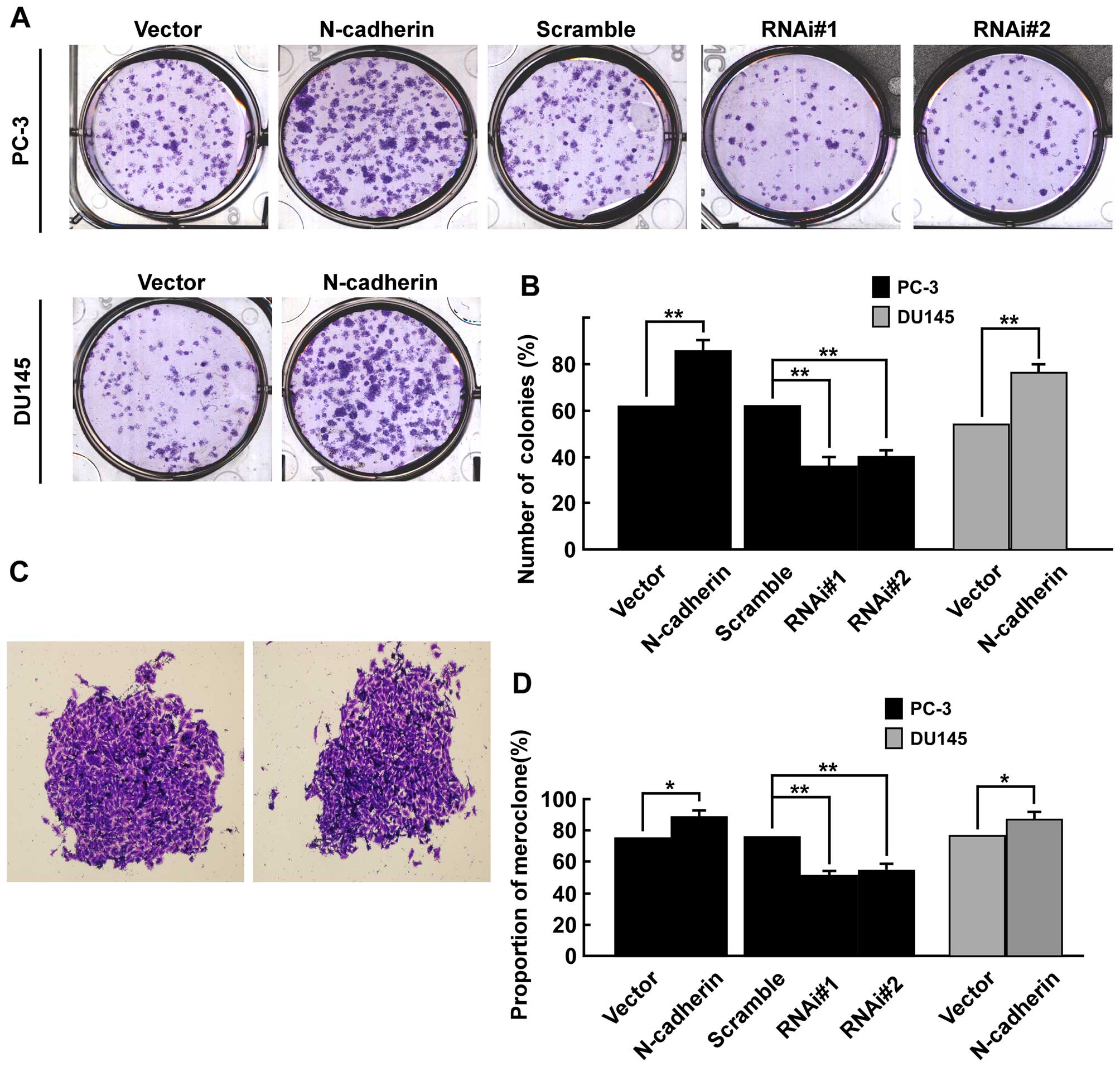 |
 |
 |
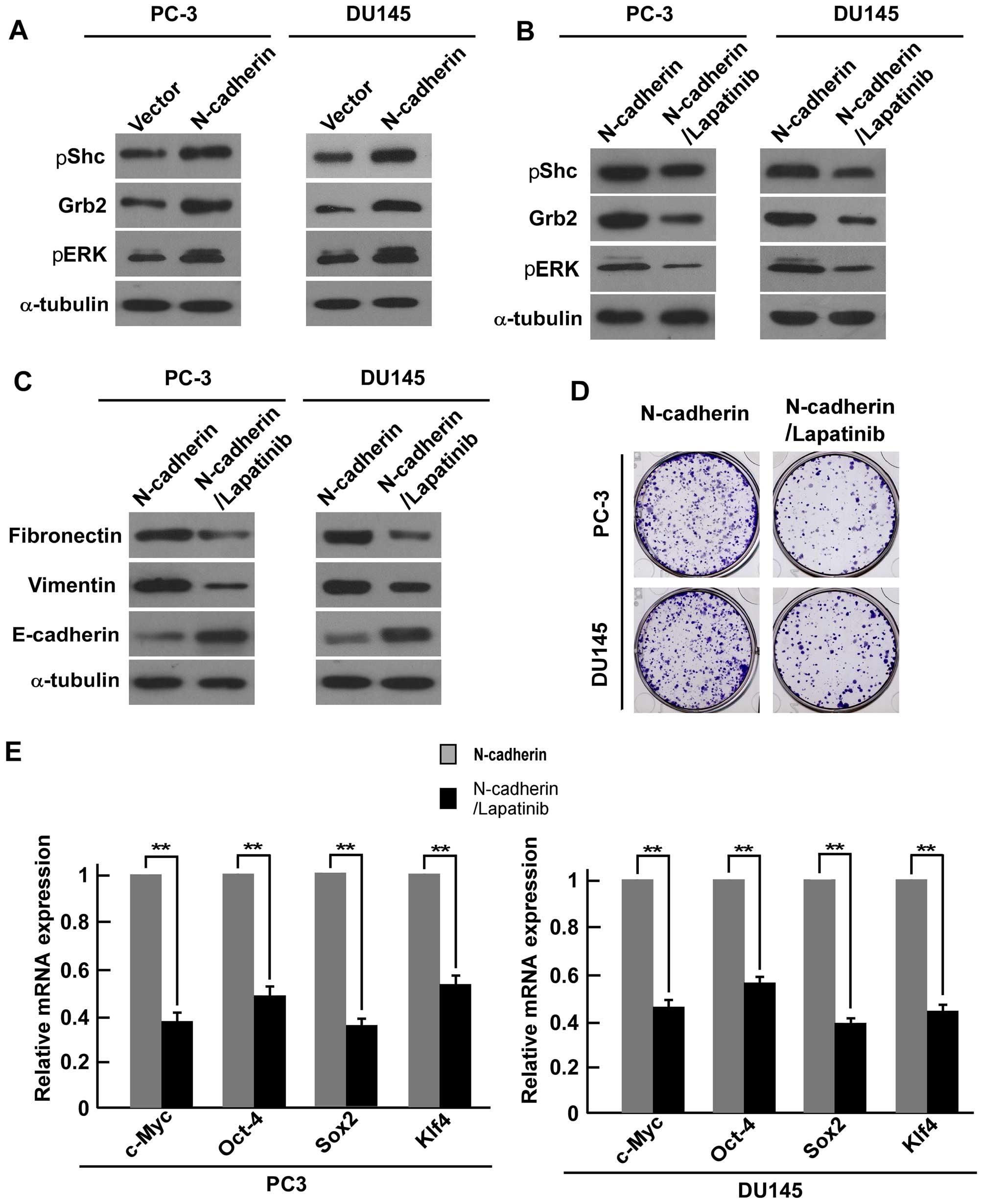 |
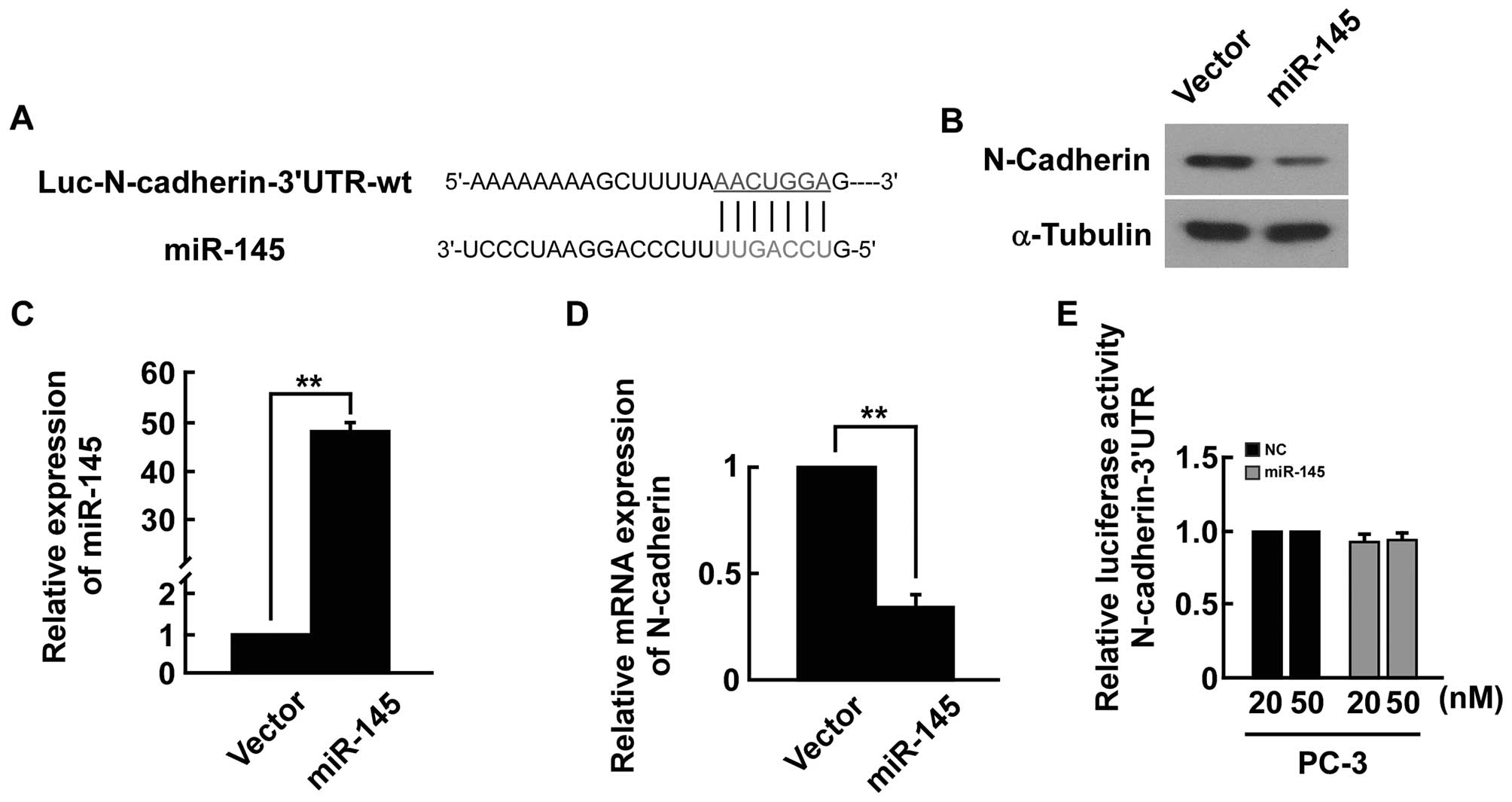 |
|
Carlin BI and Andriole GL: The natural history, skeletal complications, and management of bone metastases in patients with prostate carcinoma. Cancer. 88(Suppl): 2989–2994. 2000. View Article : Google Scholar : PubMed/NCBI | |
|
Karantanos T, Corn PG and Thompson TC: Prostate cancer progression after androgen deprivation therapy: Mechanisms of castrate resistance and novel therapeutic approaches. Oncogene. 32:5501–5511. 2013. View Article : Google Scholar : PubMed/NCBI | |
|
Friedlander TW, Ngo VT, Dong H, Premasekharan G, Weinberg V, Doty S, Zhao Q, Gilbert EG, Ryan CJ, Chen WT, et al: Detection and characterization of invasive circulating tumor cells derived from men with metastatic castration-resistant prostate cancer. Int J Cancer. 134:2284–2293. 2014. View Article : Google Scholar | |
|
Berx G, Raspé E, Christofori G, Thiery JP and Sleeman JP: Pre-EMTing metastasis? Recapitulation of morphogenetic processes in cancer. Clin Exp Metastasis. 24:587–597. 2007. View Article : Google Scholar : PubMed/NCBI | |
|
Al-Hajj M, Wicha MS, Benito-Hernandez A, Morrison SJ and Clarke MF: Prospective identification of tumorigenic breast cancer cells. Proc Natl Acad Sci USA. 100:3983–3988. 2003. View Article : Google Scholar : PubMed/NCBI | |
|
Singh SK, Hawkins C, Clarke ID, Squire JA, Bayani J, Hide T, Henkelman RM, Cusimano MD and Dirks PB: Identification of human brain tumour initiating cells. Nature. 432:396–401. 2004. View Article : Google Scholar : PubMed/NCBI | |
|
Ricci-Vitiani L, Lombardi DG, Pilozzi E, Biffoni M, Todaro M, Peschle C and De Maria R: Identification and expansion of human colon-cancer-initiating cells. Nature. 445:111–115. 2007. View Article : Google Scholar | |
|
Nagata T, Sakakura C, Komiyama S, Miyashita A, Nishio M, Murayama Y, Komatsu S, Shiozaki A, Kuriu Y, Ikoma H, et al: Expression of cancer stem cell markers CD133 and CD44 in locoregional recurrence of rectal cancer. Anticancer Res. 31:495–500. 2011.PubMed/NCBI | |
|
Merlos-Suárez A, Barriga FM, Jung P, Iglesias M, Céspedes MV, Rossell D, Sevillano M, Hernando-Momblona X, da Silva-Diz V, Muñoz P, et al: The intestinal stem cell signature identifies colorectal cancer stem cells and predicts disease relapse. Cell Stem Cell. 8:511–524. 2011. View Article : Google Scholar : PubMed/NCBI | |
|
Pirozzi G, Tirino V, Camerlingo R, Franco R, La Rocca A, Liguori E, Martucci N, Paino F, Normanno N and Rocco G: Epithelial to mesenchymal transition by TGFβ-1 induction increases stemness characteristics in primary non small cell lung cancer cell line. PLoS One. 6:e215482011. View Article : Google Scholar | |
|
Ribeiro AS and Paredes J: P-cadherin linking breast cancer stem cells and invasion: A promising marker to identify an ‘intermediate/metastable’ EMT state. Front Oncol. 4:3712014. | |
|
Li P, Yang R and Gao WQ: Contributions of epithelial-mesenchymal transition and cancer stem cells to the development of castration resistance of prostate cancer. Mol Cancer. 13:552014. View Article : Google Scholar : PubMed/NCBI | |
|
Jennbacken K, Tesan T, Wang W, Gustavsson H, Damber JE and Welén K: N-cadherin increases after androgen deprivation and is associated with metastasis in prostate cancer. Endocr Relat Cancer. 17:469–479. 2010. View Article : Google Scholar : PubMed/NCBI | |
|
Hulit J, Suyama K, Chung S, Keren R, Agiostratidou G, Shan W, Dong X, Williams TM, Lisanti MP, Knudsen K, et al: N-cadherin signaling potentiates mammary tumor metastasis via enhanced extracellular signal-regulated kinase activation. Cancer Res. 67:3106–3116. 2007. View Article : Google Scholar : PubMed/NCBI | |
|
Hui L, Zhang S, Dong X, Tian D, Cui Z and Qiu X: Prognostic significance of twist and N-cadherin expression in NSCLC. PLoS One. 8:e621712013. View Article : Google Scholar : PubMed/NCBI | |
|
Qian X, Anzovino A, Kim S, Suyama K, Yao J, Hulit J, Agiostratidou G, Chandiramani N, McDaid HM, Nagi C, et al: N-cadherin/FGFR promotes metastasis through epithelial-to-mesenchymal transition and stem/progenitor cell-like properties. Oncogene. 33:3411–3421. 2014. View Article : Google Scholar : | |
|
Tanaka H, Kono E, Tran CP, Miyazaki H, Yamashiro J, Shimomura T, Fazli L, Wada R, Huang J, Vessella RL, et al: Monoclonal antibody targeting of N-cadherin inhibits prostate cancer growth, metastasis and castration resistance. Nat Med. 16:1414–1420. 2010. View Article : Google Scholar : PubMed/NCBI | |
|
Gravdal K, Halvorsen OJ, Haukaas SA and Akslen LA: A switch from E-cadherin to N-cadherin expression indicates epithelial to mesenchymal transition and is of strong and independent importance for the progress of prostate cancer. Clin Cancer Res. 13:7003–7011. 2007. View Article : Google Scholar : PubMed/NCBI | |
|
Thompson DM and Gill GN: The EGF receptor: Structure, regulation and potential role in malignancy. Cancer Surv. 4:767–788. 1985.PubMed/NCBI | |
|
Heimberger AB, Suki D, Yang D, Shi W and Aldape K: The natural history of EGFR and EGFRvIII in glioblastoma patients. J Transl Med. 3:382005. View Article : Google Scholar : PubMed/NCBI | |
|
Puputti M, Tynninen O, Sihto H, Blom T, Mäenpää H, Isola J, Paetau A, Joensuu H and Nupponen NN: Amplification of KIT, PDGFRA, VEGFR2, and EGFR in gliomas. Mol Cancer Res. 4:927–934. 2006. View Article : Google Scholar : PubMed/NCBI | |
|
Lee JC, Vivanco I, Beroukhim R, Huang JH, Feng WL, DeBiasi RM, Yoshimoto K, King JC, Nghiemphu P, Yuza Y, et al: Epidermal growth factor receptor activation in glioblastoma through novel missense mutations in the extracellular domain. PLoS Med. 3:e4852006. View Article : Google Scholar : PubMed/NCBI | |
|
Sharma SV, Bell DW, Settleman J and Haber DA: Epidermal growth factor receptor mutations in lung cancer. Nat Rev Cancer. 7:169–181. 2007. View Article : Google Scholar : PubMed/NCBI | |
|
Marchetti A, Martella C, Felicioni L, Barassi F, Salvatore S, Chella A, Camplese PP, Iarussi T, Mucilli F, Mezzetti A, et al: EGFR mutations in non-small-cell lung cancer: Analysis of a large series of cases and development of a rapid and sensitive method for diagnostic screening with potential implications on pharmacologic treatment. J Clin Oncol. 23:857–865. 2005. View Article : Google Scholar : PubMed/NCBI | |
|
Sholl LM, Yeap BY, Iafrate AJ, Holmes-Tisch AJ, Chou YP, Wu MT, Goan YG, Su L, Benedettini E, Yu J, et al: Lung adenocarcinoma with EGFR amplification has distinct clinicopathologic and molecular features in never-smokers. Cancer Res. 69:8341–8348. 2009. View Article : Google Scholar : PubMed/NCBI | |
|
Dacic S, Flanagan M, Cieply K, Ramalingam S, Luketich J, Belani C and Yousem SA: Significance of EGFR protein expression and gene amplification in non-small cell lung carcinoma. Am J Clin Pathol. 125:860–865. 2006. View Article : Google Scholar : PubMed/NCBI | |
|
Sainsbury JR, Farndon JR, Needham GK, Malcolm AJ and Harris AL: Epidermal-growth-factor receptor status as predictor of early recurrence of and death from breast cancer. Lancet. 1:1398–1402. 1987.PubMed/NCBI | |
|
Bhargava R, Gerald WL, Li AR, Pan Q, Lal P, Ladanyi M and Chen B: EGFR gene amplification in breast cancer: Correlation with epidermal growth factor receptor mRNA and protein expression and HER-2 status and absence of EGFR-activating mutations. Mod Pathol. 18:1027–1033. 2005. View Article : Google Scholar : PubMed/NCBI | |
|
Kallioniemi OP, Kallioniemi A, Kurisu W, Thor A, Chen LC, Smith HS, Waldman FM, Pinkel D and Gray JW: ERBB2 amplification in breast cancer analyzed by fluorescence in situ hybridization. Proc Natl Acad Sci USA. 89:5321–5325. 1992. View Article : Google Scholar : PubMed/NCBI | |
|
Dybdal N, Leiberman G, Anderson S, McCune B, Bajamonde A, Cohen RL, Mass RD, Sanders C and Press MF: Determination of HER2 gene amplification by fluorescence in situ hybridization and concordance with the clinical trials immunohistochemical assay in women with metastatic breast cancer evaluated for treatment with trastuzumab. Breast Cancer Res Treat. 93:3–11. 2005. View Article : Google Scholar : PubMed/NCBI | |
|
Zhao J, Wu R, Au A, Marquez A, Yu Y and Shi Z: Determination of HER2 gene amplification by chromogenic in situ hybridization (CISH) in archival breast carcinoma. Mod Pathol. 15:657–665. 2002. View Article : Google Scholar : PubMed/NCBI | |
|
Jenndahl LE, Isakson P and Baeckström D: c-erbB2-induced epithelial-mesenchymal transition in mammary epithelial cells is suppressed by cell-cell contact and initiated prior to E-cadherin downregulation. Int J Oncol. 27:439–448. 2005.PubMed/NCBI | |
|
Lu J, Guo H, Treekitkarnmongkol W, Li P, Zhang J, Shi B, Ling C, Zhou X, Chen T, Chiao PJ, et al: 14-3-3zeta cooperates with ErbB2 to promote ductal carcinoma in situ progression to invasive breast cancer by inducing epithelial-mesenchymal transition. Cancer Cell. 16:195–207. 2009. View Article : Google Scholar : PubMed/NCBI | |
|
Ai M, Liang K, Lu Y, Qiu S and Fan Z: Brk/PTK6 cooperates with HER2 and Src in regulating breast cancer cell survival and epithelial-to-mesenchymal transition. Cancer Biol Ther. 14:237–245. 2013. View Article : Google Scholar : PubMed/NCBI | |
|
Clark PA, Iida M, Treisman DM, Kalluri H, Ezhilan S, Zorniak M, Wheeler DL and Kuo JS: Activation of multiple ERBB family receptors mediates glioblastoma cancer stem-like cell resistance to EGFR-targeted inhibition. Neoplasia. 14:420–428. 2012. View Article : Google Scholar : PubMed/NCBI | |
|
Abhold EL, Kiang A, Rahimy E, Kuo SZ, Wang-Rodriguez J, Lopez JP, Blair KJ, Yu MA, Haas M, Brumund KT, et al: EGFR kinase promotes acquisition of stem cell-like properties: A potential therapeutic target in head and neck squamous cell carcinoma stem cells. PLoS One. 7:e324592012. View Article : Google Scholar : PubMed/NCBI | |
|
Li J, Gong L-Y, Song L-B, Jiang L-L, Liu L-P, Wu J, Yuan J, Cai J-C, He M, Wang L, et al: Oncoprotein Bmi-1 renders apoptotic resistance to glioma cells through activation of the IKK-nuclear factor-κB pathway. Am J Pathol. 176:699–709. 2010. View Article : Google Scholar : | |
|
Chen T, Xu C, Chen J, Ding C, Xu Z, Li C and Zhao J: MicroRNA-203 inhibits cellular proliferation and invasion by targeting Bmi1 in non-small cell lung cancer. Oncol Lett. 9:2639–2646. 2015.PubMed/NCBI | |
|
Saeed AI, Sharov V, White J, Li J, Liang W, Bhagabati N, Braisted J, Klapa M, Currier T, Thiagarajan M, et al: TM4: A free, open-source system for microarray data management and analysis. Biotechniques. 34:374–378. 2003.PubMed/NCBI | |
|
Guo W, Ren D, Chen X, Tu X, Huang S, Wang M, Song L, Zou X and Peng X: HEF1 promotes epithelial mesenchymal transition and bone invasion in prostate cancer under the regulation of microRNA-145. J Cell Biochem. 114:1606–1615. 2013. View Article : Google Scholar : PubMed/NCBI | |
|
Livak KJ and Schmittgen TD: Analysis of relative gene expression data using real-time quantitative PCR and the 2(−Delta Delta C(T)) method. Methods. 25:402–408. 2001. View Article : Google Scholar | |
|
Guan H, Song L, Cai J, Huang Y, Wu J, Yuan J, Li J and Li M: Sphingosine kinase 1 regulates the Akt/FOXO3a/Bim pathway and contributes to apoptosis resistance in glioma cells. PLoS One. 6:e199462011. View Article : Google Scholar : PubMed/NCBI | |
|
Nalla AK, Estes N, Patel J and Rao JS: N-cadherin mediates angiogenesis by regulating monocyte chemoattractant protein-1 expression via PI3K/Akt signaling in prostate cancer cells. Exp Cell Res. 317:2512–2521. 2011. View Article : Google Scholar : PubMed/NCBI | |
|
Rosenberg EE, Prudnikova TY, Zabarovsky ER, Kashuba VI and Grigorieva EV: D-glucuronyl C5-epimerase cell type specifically affects angiogenesis pathway in different prostate cancer cells. Tumour Biol. 35:3237–3245. 2014. View Article : Google Scholar | |
|
Allegra A, Alonci A, Penna G, Innao V, Gerace D, Rotondo F and Musolino C: The cancer stem cell hypothesis: A guide to potential molecular targets. Cancer Invest. 32:470–495. 2014. View Article : Google Scholar : PubMed/NCBI | |
|
Pfeiffer MJ and Schalken JA: Stem cell characteristics in prostate cancer cell lines. Eur Urol. 57:246–254. 2010. View Article : Google Scholar | |
|
Hazan RB, Kang L, Whooley BP and Borgen PI: N-cadherin promotes adhesion between invasive breast cancer cells and the stroma. Cell Adhes Commun. 4:399–411. 1997. View Article : Google Scholar : PubMed/NCBI | |
|
Hazan RB, Phillips GR, Qiao RF, Norton L and Aaronson SA: Exogenous expression of N-cadherin in breast cancer cells induces cell migration, invasion, and metastasis. J Cell Biol. 148:779–790. 2000. View Article : Google Scholar : PubMed/NCBI | |
|
Jaggi M, Nazemi T, Abrahams NA, Baker JJ, Galich A, Smith LM and Balaji KC: N-cadherin switching occurs in high Gleason grade prostate cancer. Prostate. 66:193–199. 2006. View Article : Google Scholar | |
|
Caramel J, Papadogeorgakis E, Hill L, Browne GJ, Richard G, Wierinckx A, Saldanha G, Osborne J, Hutchinson P, Tse G, et al: A switch in the expression of embryonic EMT-inducers drives the development of malignant melanoma. Cancer Cell. 24:466–480. 2013. View Article : Google Scholar : PubMed/NCBI | |
|
Siegel R, DeSantis C, Virgo K, Stein K, Mariotto A, Smith T, Cooper D, Gansler T, Lerro C, Fedewa S, et al: Cancer treatment and survivorship statistics, 2012. CA Cancer J Clin. 62:220–241. 2012. View Article : Google Scholar : PubMed/NCBI | |
|
Pagliarulo V, Bracarda S, Eisenberger MA, Mottet N, Schröder FH, Sternberg CN and Studer UE: Contemporary role of androgen deprivation therapy for prostate cancer. Eur Urol. 61:11–25. 2012. View Article : Google Scholar : | |
|
Brabletz T: EMT and MET in metastasis: Where are the cancer stem cells? Cancer Cell. 22:699–701. 2012. View Article : Google Scholar : PubMed/NCBI | |
|
Bracken CP, Gregory PA, Kolesnikoff N, Bert AG, Wang J, Shannon MF and Goodall GJ: A double-negative feedback loop between ZEB1-SIP1 and the microRNA-200 family regulates epithelial-mesenchymal transition. Cancer Res. 68:7846–7854. 2008. View Article : Google Scholar : PubMed/NCBI | |
|
Korpal M, Lee ES, Hu G and Kang Y: The miR-200 family inhibits epithelial-mesenchymal transition and cancer cell migration by direct targeting of E-cadherin transcriptional repressors ZEB1 and ZEB2. J Biol Chem. 283:14910–14914. 2008. View Article : Google Scholar : PubMed/NCBI | |
|
Moes M, Le Béchec A, Crespo I, Laurini C, Halavatyi A, Vetter G, Del Sol A and Friederich E: A novel network integrating a miRNA-203/SNAI1 feedback loop which regulates epithelial to mesenchymal transition. PLoS One. 7:e354402012. View Article : Google Scholar : PubMed/NCBI | |
|
Nicoloso MS, Spizzo R, Shimizu M, Rossi S and Calin GA: MicroRNAs - the micro steering wheel of tumour metastases. Nat Rev Cancer. 9:293–302. 2009. View Article : Google Scholar : PubMed/NCBI | |
|
Siemens H, Jackstadt R, Hünten S, Kaller M, Menssen A, Götz U and Hermeking H: miR-34 and SNAIL form a double-negative feedback loop to regulate epithelial-mesenchymal transitions. Cell Cycle. 10:4256–4271. 2011. View Article : Google Scholar : PubMed/NCBI | |
|
Ren D, Wang M, Guo W, Huang S, Wang Z, Zhao X, Du H, Song L and Peng X: Double-negative feedback loop between ZEB2 and miR-145 regulates epithelial-mesenchymal transition and stem cell properties in prostate cancer cells. Cell Tissue Res. 358:763–778. 2014. View Article : Google Scholar : PubMed/NCBI | |
|
Huang S, Guo W, Tang Y, Ren D, Zou X and Peng X: miR-143 and miR-145 inhibit stem cell characteristics of PC-3 prostate cancer cells. Oncol Rep. 28:1831–1837. 2012.PubMed/NCBI | |
|
Gao P, Xing AY, Zhou GY, Zhang TG, Zhang JP, Gao C, Li H and Shi DB: The molecular mechanism of microRNA-145 to suppress invasion-metastasis cascade in gastric cancer. Oncogene. 32:491–501. 2013. View Article : Google Scholar |









